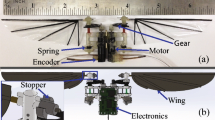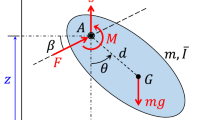Abstract
Most hovering aircraft such as helicopters and animal-inspired flapping-wing flyers are dynamically unstable in flight, quickly tumbling in the absence of feedback control. The addition of feedback loops can stabilize, but at the cost of additional sensing and actuation components. This can add expense, weight, and complexity. An alternative to feedback is the use of passive mechanisms such as aerodynamic drag to stabilize attitude. Previous work has suggested that small aircraft can be stabilized by adding air dampers above and below the center of mass. We present flight tests of an insect-scale robot operating under this principle. When controlled to a constant altitude, it remains stably upright while undergoing cyclic attitude oscillations. To characterize these oscillations, we present a nonlinear analytic model derived from first principles that reproduces the observed behavior. Using numerical simulation, we analyze how changing damper size, position, mass, and midpoint offset affect these oscillations, building on previous work that considered only a single configuration. Our results indicate that only by increasing damper size can lateral oscillation amplitude be significantly reduced, at the cost of increased damper mass. Additionally, we show that as scale diminishes, the damper size must get relatively larger. This suggests that smaller damper-equipped robots must operate in low-wind areas or in boundary-layer flow near surfaces.














Similar content being viewed by others
Notes
A detailed analysis suggests that if instead the damper is considered to be made of beams that must support the load of a impact landing, quadratic scaling is reasonable. We consider the damper support structure as a simply-supported beam. We neglect the mass of the polyester layer because it has similar density (\(\approx \)15 kg/m\(^{3}\)) to carbon fiber but a much lower thickness, at \(3~\upmu \) m compared to \(80~\upmu \) m for the carbon fiber composite. Assume the maximum force the beam is expected to support is \(F^{*}\), caused by, for example, crash landings. Then the greatest moment applied to the beam of length l occurs at its base, and is equal to \(M^{*}=F^{*}l\). Suppose the beam has a width w and thickness t (\(\approx \)80 \(\upmu \) m for our material). Tensile stress inside the beam at its base is \(\sigma =\frac{M^{*}y}{I}\), where \(I=\frac{wt^{3}}{12}\) is the moment of inertia of the rectangular beam and y is the distance from its centerline. Then maximum stress \(\sigma ^{*}\) in the material occurs at the top and bottom of the beam, and is equal to3 \(\sigma ^{*}=\frac{M^{*}t/2}{I}\).
Our interest is in a scaling law that, for a constant load \(F^{*}\) and material strength \(\sigma ^{*}\), gives the mass of the damper. Substituting the above equations into each other, we find that, for constant t (that is, a fixed fabrication process), the width of the beam must be \(w=6\frac{F^{*}}{\sigma ^{*}}\frac{l}{t^{2}}\). The mass of a single beam is \(m=\rho lwt\), where \(\rho \) is the density of the material. Substituting, we find that the mass must be \(m=6\rho \frac{F^{*}}{\sigma ^{*}}\frac{l^{2}}{t}\), or, written more succinctly, \(m=k_{m}l^{2}\) for all other terms kept constant. To find the value of \(k_{m}\), rather than compute these terms, we simply calibrate it to a damper design that, after a few iterations, has been found to support the necessary loads. In this case, the damper consists of many separate beams, all of which are of the same thickness of carbon fiber and must support similar loads.
References
Abzug, M. J., & Larrabee, E. E. (2002). Airplane stability and control. A history of the technologies that made aviation possible (2nd ed.). Cambridge: Cambridge University Press.
Åström, K. J., & Murray, R. M. (2008). Feedback systems: An introduction for scientists and engineers. Princeton: Princeton University Press.
Blevins, R. D. (2015). Formulas for dynamics, acoustics and vibration. New York: Wiley.
Chirarattananon, P. C., & Wood, R. J. (2013). Identification of flight aerodynamics for flapping-wing microrobots. In 2013 IEEE international conference on robotics and automation (ICRA).
De Croon, G., De Clercq, K., Ruijsink, R., Remes, B., & De Wagter, C. (2009). Design, aerodynamics, and vision-based control of the delfly. International Journal of Micro Air Vehicles, 1(2), 71–97.
Dickinson, M. H. (1999). Haltere-mediated equilibrium reflexes of the fruit fly, drosophila melanogaster. Philosophical Transactions of the Royal Society of London B, 354, 903–916.
Dickinson, M. H., & Götz, K. G. (1996). The wake dynamics and flight forces of the fruit fly drosophila melanogaster. Journal of Experimental Biology, 199(9), 2085–2104.
Dickinson, M. H., Lehmann, F. O., & Sane, S. P. (1999). Wing rotation and the aerodynamic basis of insect flight. Science, 284(5422), 1954–1960.
Dudley, R. (2002). The biomechanics of insect flight: Form, function, evolution. Princeton: Princeton University Press.
Eberle, A., Dickerson, B., Reinhall, P. G., & Daniel, T. (2015). A new twist on gyroscopic sensing: Body rotations lead to torsion in flapping, flexing insect wings. Journal of the Royal Society Interface, 12(104), 20141,088.
Ellington, C. P. (1984). The aerodynamics of hovering insect flight. ii. Morphological parameters. Philosophical Transactions of the Royal Society of London B, Biological Sciences, 305(1122), 17–40. doi:10.1098/rstb.1984.0050.
Ellington, C. P., Van Den Berg, C., Willmott, A. P., & Thomas, A. L. (1996). Leading-edge vortices in insect flight. Nature, 384(19), 626–630.
Fearing, R., Chiang, K., Dickinson, M., Pick, D., Sitti, M., & Yan, J. (2000). Wing transmission for a micromechanical flying insect. In IEEE international conference on robotics and automation (ICRA) vol. 2, (pp. 1509–1516).
Finio, B. M., Pérez-Arancibia, N. O., & Wood, R. J. (2011). System identification and linear time-invariant modeling of an insect-sized flapping-wing micro air vehicle. In 2011 IEEE/RSJ international conference on intelligent robots and systems (IROS).
Fuller, S. B., Helbling, E. F., Chirarattananon, P., & Wood, R. J. (2014a). Using aMEMS gyroscope to stabilize the attitude of a fly-sized hovering robots. In 2014 International conference on micro air vehicle (IMAV), Delft, The Netherlands.
Fuller, S. B., Karpelson, M., Censi, A., Ma, K. Y., & Wood, R. J. (2014b). Controlling free flight of a robotic fly using an onboard vision sensor inspired by insect ocelli. Jouranl of the Royal Society Interface. doi:10.1098/rsif.2014.0281.
Gravish, N., Peters, J. M., Combes, S. A., & Wood, R. J. (2015). Collective flow enhancement by tandem flapping wings. Physical Review Letters, 115(18), 188101.
Helbling, E. F., Fuller, S. B., & Wood, R. J. (2014). Pitch and yaw control of a robotic insect using an onboard magnetometer. In 2014 IEEE international conference on robotics and automation (ICRA).
Hoerner, S. F. (1965). Fluid-dynamic drag: Practical information on aerodynamic drag and hydrodynamic resistance. Midland Park: Hoerner Fluid Dynamics.
Keennon, M., Klingebiel, K., Won, H., & Andriukov, A. (2012). Development of the nano hummingbird: A tailless flapping wing micro air vehicle. In AIAA aerospace sciences meeting, AIAA, Reston, VA (pp. 1–24). doi:10.2514/6.2012-588.
Kroo, I., & Kunz, P. (2000). Development of the mesicopter: A miniature autonomous rotorcraft. In American helicopter society (AHS) vertical lift aircraft design conference, San Francisco, CA.
Ma, K. Y., Felton, S. M., & Wood, R. J. (2012). Design, fabrication, and modeling of the splitactuator microrobotic bee. In 2012 IEEE international conference on robotics and automation (ICRA), St. Paul, MN (pp. 1133–1140).
Ma, K. Y., Chirarattananon, P., Fuller, S. B., & Wood, R. (2013). Controlled flight of a biologically inspired, insect-scale robot. Science, 340(6132), 603–607.
Macnab, R. M., & Koshland, D. (1972). The gradient-sensing mechanism in bacterial chemotaxis. Proceedings of the National Academy of Sciences, 69(9), 2509–2512.
Pérez-Arancibia, N. O., Ma, K. Y., Galloway, K. C., Greenberg, J. D., & Wood, R. J. (2011). First controlled vertical flight of a biologically inspired microrobot. Bioinspiration and Biomimetics, 6(3), 036009. doi:10.1088/1748-3182/6/3/036009.
Pesavento, U., & Wang, Z. (2009). Flapping wing flight can save aerodynamic power compared to steady flight. Physical Review Letters, 103(11), 118,102.
Pringle, J. W. S. (1948). The gyroscopic mechanism of the halteres of diptera. Philosophical Transactions of the Royal Society of London Series B, Biological Sciences, 233(602), 347–384.
Richter, C., & Lipson, H. (2011). Untethered hovering flapping flight of a 3d-printed mechanical insect. Artificial Life, 17(2), 73–86.
Ristroph, L., Bergou, A. J., Ristroph, G., Coumes, K., Berman, G. J., Guckenheimer, J., et al. (2010). Discovering the flight autostabilizer of fruit flies by inducing aerial stumbles. Proceedings of the National Academy of Sciences, 107(11), 4820–4824. doi:10.1073/pnas.1000615107.
Ristroph, L., Ristroph, G., Morozova, S., Bergou, A. J., Chang, S., Guckenheimer, J., et al. (2013). Active and passive stabilization of body pitch in insect flight. Journal of the Royal Society Interface. doi:10.1098/rsif.2013.0237.
Sane, S. P., & Dickinson, M. H. (2001). The control of flight force by a flapping wing: Lift and drag production. The Journal of Experimental Biology, 204, 2607–2626.
Sane, S. P., Dieudonné, A., Willis, M. A., & Daniel, T. L. (2007). Antennal mechanosensors mediate flight control in moths. Science, 315(5813), 863–866. doi:10.1126/science.1133598.
Sreetharan, P., & Wood, R. J. (2011). Passive torque regulation in an underactuated flapping wing robotic insect. Autonomous Robots, 31(2–3), 225–234.
Tanaka, H., & Shimoyama, I. (2010). Forward flight of swallowtail butterfly with simple flapping motion. Bioinspiration & Biomimetics, 5(2), 026003. doi:10.1088/1748-3182/5/2/026003.
Teoh, Z. E., Fuller, S. B., Chirarattananon, P. C., Pérez-Arancibia, N. O., Greenberg, J. D., & Wood, R. J. (2012). A hovering flapping-wing microrobot with altitude control andpassive upright stability. In 2012 IEEE/RSJ international conference on intelligent robots and systems (IROS), Vilamoura, Algarve, Portugal (pp. 3209–3216).
Trimmer, W. S. N. (1989). Microbots and micromechanical systems. Sensors and Actuators, 19, 267–287.
Ulrich, E., Pines, D., & Humbert, J. S. (2010). From falling to flying: The path to powered flight of a robotic samara nano air vehicle. Bioinspiration & Biomimetics, 5(045), 009.
van Breugel, F., Regan, W., & Lipson, H. (2008). From insects to machines. IEEE Robotics & Automation Magazine, 15(4), 68–74. doi:10.1109/MRA.2008.929923.
Wang, Z. J., Birch, J. M., & Dickinson, M. H. (2004). Unsteady forces and flows in low reynolds number hovering flight: Two-dimensional computations versus robotic wing experiments. Journal of Experimental Biology, 207(3), 449–460. doi:10.1242/jeb.00739.
Whitney, J., Sreetharan, P., Ma, K., & Wood, R. (2011). Pop-up book mems. Journal of Micromechanics and Microengineering, 21(11), 115021.
Wilson, M. (1978). The functional organisation of locust ocelli. Journal of Comparative Physiology, 124(4), 297–316. doi:10.1007/BF00661380.
Wood, R. J. (2008). The first takeoff of a biologically inspired at-scale robotic insect. IEEE Transactions on Robotics, 24(2), 341–347. doi:10.1109/TRO.2008.916997.
Wood, R. J., Avadhanula, S., Menon, M., & Fearing, R. S. (2003). Microrobotics using composite materials: The micromechanical flying insect thorax. In 2003 ieee international conference on robotics and automation (ICRA) (vol. 2 pp. 1842–1849). doi:10.1109/ROBOT.2003.1241863.
Wood, R. J., Avadhanula, S., Sahai, R., Steltz, E., & Fearing, R. S. (2008). Microrobot design using fiber reinforced composites. Journal of Mechanical Design, 130, 052304.
Zdunich, P., Bilyk, D., MacMaster, M., Loewen, D., DeLaurier, J., Kornbluh, R., et al. (2007). Development and testing of the mentor flapping-wing micro air vehicle. Journal of Aircraft, 44(5), 1701–1711.
Acknowledgements
This work was partially supported by the National Science Foundation (Award Nos. CCF-0926148 and CMMI-0746638) and the Wyss Institute for Biologically Inspired Engineering. Any opinions, findings, and conclusions or recommendations expressed in this material are those of the authors and do not necessarily reflect the views of the National Science Foundation. The authors wish to thank Longlong Chang for showing us that the original analysis was missing an inertial added mass term and Will Dickson for insightful discussions.
Author information
Authors and Affiliations
Corresponding author
Electronic supplementary material
Below is the link to the electronic supplementary material.
Supplementary material 1 (mp4 14859 KB)
Rights and permissions
About this article
Cite this article
Fuller, S.B., Teoh, Z.E., Chirarattananon, P. et al. Stabilizing air dampers for hovering aerial robotics: design, insect-scale flight tests, and scaling. Auton Robot 41, 1555–1573 (2017). https://doi.org/10.1007/s10514-017-9623-3
Received:
Accepted:
Published:
Issue Date:
DOI: https://doi.org/10.1007/s10514-017-9623-3




